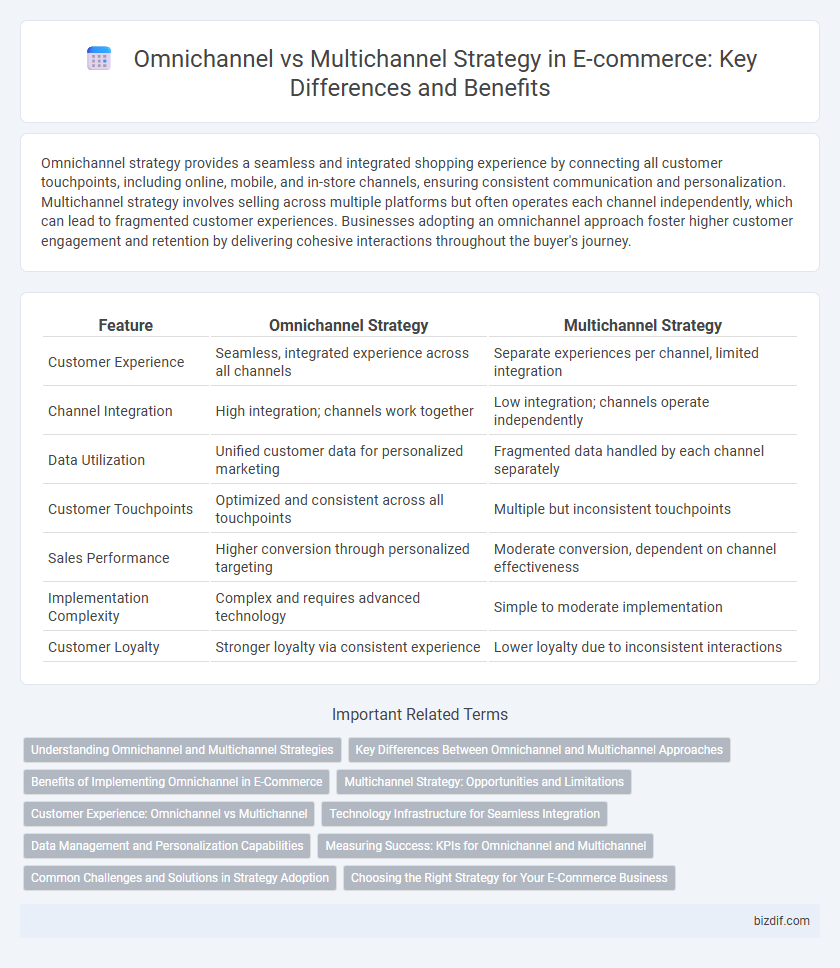Omnichannel strategy provides a seamless and integrated shopping experience by connecting all customer touchpoints, including online, mobile, and in-store channels, ensuring consistent communication and personalization. Multichannel strategy involves selling across multiple platforms but often operates each channel independently, which can lead to fragmented customer experiences. Businesses adopting an omnichannel approach foster higher customer engagement and retention by delivering cohesive interactions throughout the buyer's journey.
Table of Comparison
| Feature | Omnichannel Strategy | Multichannel Strategy |
|---|---|---|
| Customer Experience | Seamless, integrated experience across all channels | Separate experiences per channel, limited integration |
| Channel Integration | High integration; channels work together | Low integration; channels operate independently |
| Data Utilization | Unified customer data for personalized marketing | Fragmented data handled by each channel separately |
| Customer Touchpoints | Optimized and consistent across all touchpoints | Multiple but inconsistent touchpoints |
| Sales Performance | Higher conversion through personalized targeting | Moderate conversion, dependent on channel effectiveness |
| Implementation Complexity | Complex and requires advanced technology | Simple to moderate implementation |
| Customer Loyalty | Stronger loyalty via consistent experience | Lower loyalty due to inconsistent interactions |
Understanding Omnichannel and Multichannel Strategies
Omnichannel strategy integrates multiple sales channels to create a seamless and unified customer experience, ensuring consistent branding and communication across online stores, physical locations, mobile apps, and social media platforms. Multichannel strategy involves using various independent channels to reach customers, where each channel operates separately without necessarily sharing data or customer insights. Understanding the distinction between these strategies helps e-commerce businesses optimize customer engagement, personalization, and operational efficiency.
Key Differences Between Omnichannel and Multichannel Approaches
Omnichannel strategy integrates customer interactions across all channels into a seamless experience, whereas multichannel strategy operates each channel independently without unified customer engagement. Omnichannel emphasizes data synchronization and personalized experiences across platforms, while multichannel often lacks cohesive customer journey tracking and cross-channel communication. Key differences include customer-centric integration in omnichannel versus channel-specific focus in multichannel, impacting overall brand consistency and user satisfaction.
Benefits of Implementing Omnichannel in E-Commerce
Implementing an omnichannel strategy in e-commerce enhances customer experience by providing seamless interactions across all platforms, increasing engagement and loyalty. It enables businesses to gather unified customer data, allowing for personalized marketing and more efficient inventory management. This integrated approach boosts sales conversion rates and strengthens brand consistency, driving long-term growth in competitive markets.
Multichannel Strategy: Opportunities and Limitations
Multichannel strategy in e-commerce offers businesses multiple sales channels such as online marketplaces, social media platforms, and physical stores, increasing customer reach and brand visibility. However, limited integration between channels can lead to inconsistent customer experiences and data silos, hindering personalized marketing and inventory management. Optimizing each channel independently provides opportunities for targeted promotions, but requires robust coordination to prevent fragmentation and maximize overall sales performance.
Customer Experience: Omnichannel vs Multichannel
An omnichannel strategy delivers a seamless and unified customer experience across all platforms, integrating online, mobile, and physical stores to ensure consistent interaction and personalized engagement. In contrast, a multichannel strategy provides multiple selling avenues without necessarily linking them, often resulting in disjointed experiences and inconsistent messaging. Omnichannel approaches significantly enhance customer satisfaction and loyalty by enabling smooth transitions and unified support throughout the buyer journey.
Technology Infrastructure for Seamless Integration
A robust omnichannel strategy leverages advanced technology infrastructure, including integrated CRM systems, real-time inventory management, and unified customer data platforms to ensure seamless customer experiences across all touchpoints. In contrast, a multichannel strategy often relies on disparate systems that operate independently, causing challenges in synchronizing data and delivering consistent interactions. Investing in scalable APIs and cloud-based solutions enables omnichannel approaches to provide a cohesive, data-driven interface that enhances customer engagement and operational efficiency.
Data Management and Personalization Capabilities
Omnichannel strategy integrates data from all customer touchpoints into a unified system, enabling seamless personalization and consistent experiences across channels. Multichannel strategy operates channels independently, often leading to fragmented data and limited personalization capabilities. Effective data management in an omnichannel approach drives advanced customer segmentation, predictive analytics, and tailored marketing interventions, boosting conversion rates and customer loyalty.
Measuring Success: KPIs for Omnichannel and Multichannel
Key performance indicators (KPIs) for omnichannel strategies include customer lifetime value (CLV), cross-channel engagement rates, and unified customer satisfaction scores, reflecting seamless integration across platforms. Multichannel KPIs primarily focus on individual channel performance metrics such as channel-specific conversion rates, average order value per channel, and channel ROI. Tracking these distinct KPIs enables e-commerce businesses to evaluate effectiveness in customer retention and sales growth through either integrated or isolated channel approaches.
Common Challenges and Solutions in Strategy Adoption
Omnichannel and multichannel strategies often face common challenges such as inconsistent customer experiences, data silos, and integration complexities across platforms. Effective solutions include implementing unified customer data platforms, ensuring seamless cross-channel communication, and investing in robust IT infrastructure to synchronize inventory and sales data. Addressing these issues enhances customer engagement, drives sales growth, and ensures a cohesive brand presence across all touchpoints.
Choosing the Right Strategy for Your E-Commerce Business
Selecting the right approach between omnichannel and multichannel strategies is crucial for e-commerce success. Omnichannel strategy integrates customer experiences across all platforms, ensuring seamless interactions, while multichannel offers multiple sales avenues without full integration. Businesses aiming for personalized, consistent customer journeys benefit from omnichannel, whereas those wanting broad market reach might prefer multichannel.
Omnichannel Strategy vs Multichannel Strategy Infographic

 bizdif.com
bizdif.com